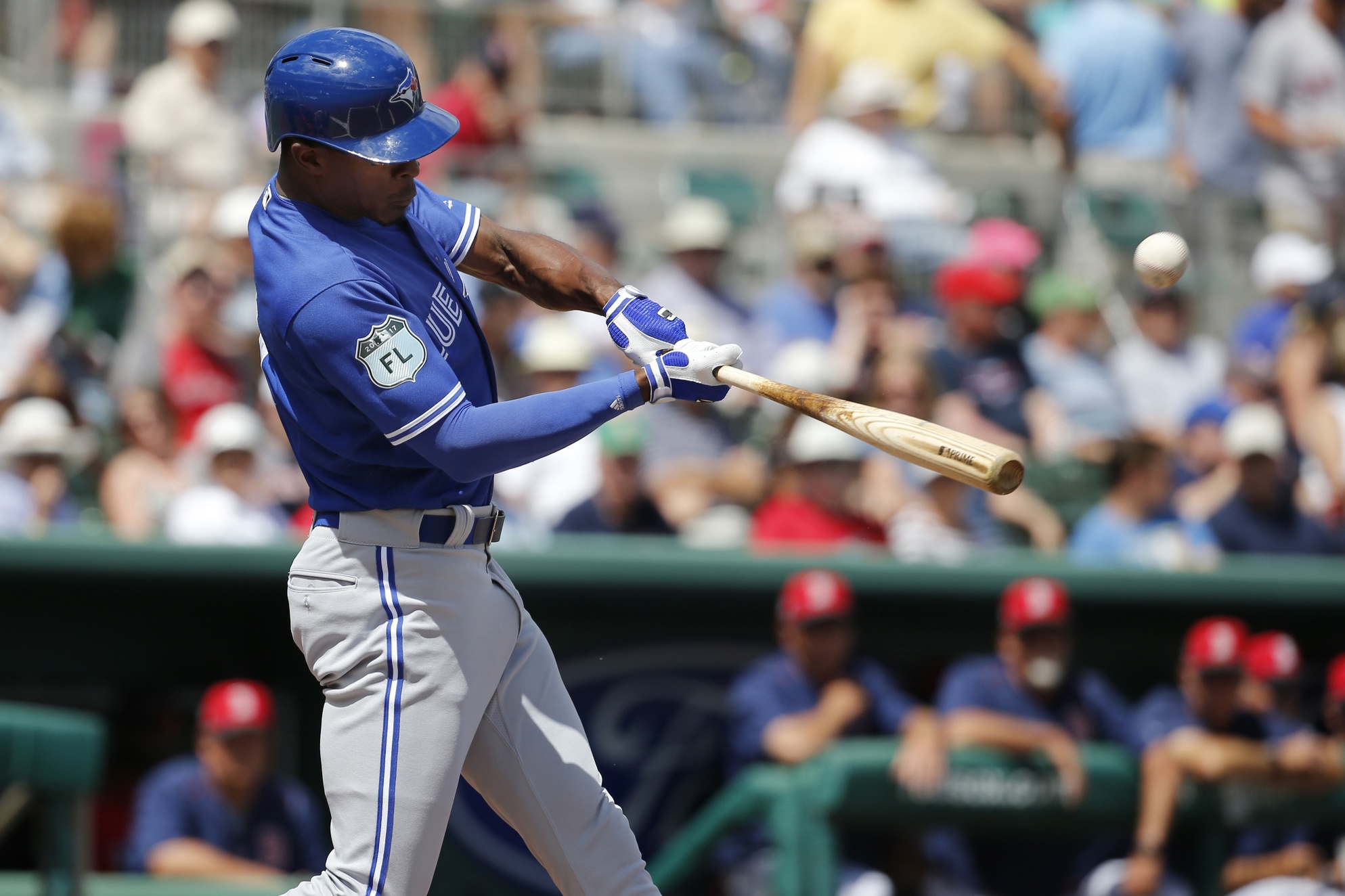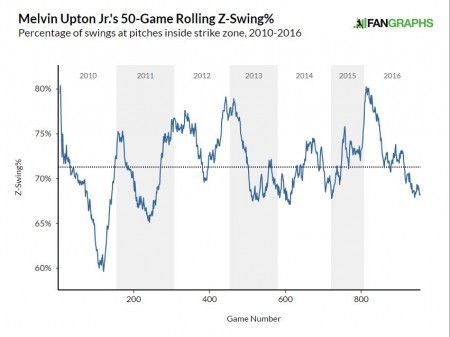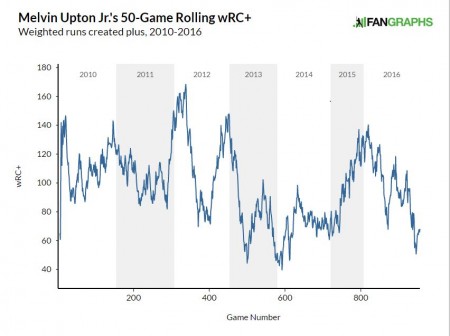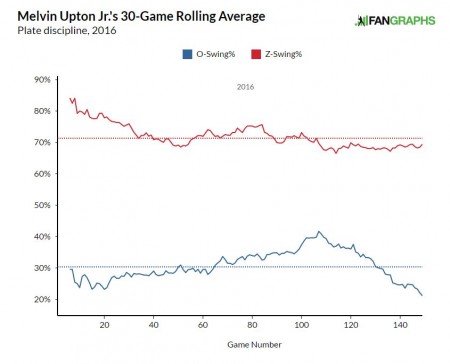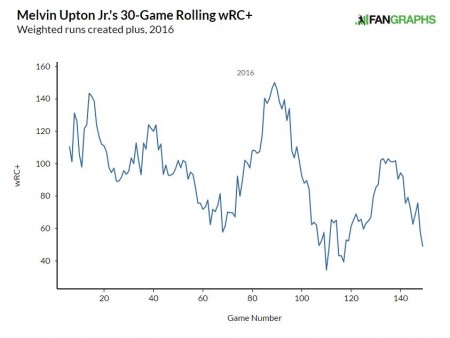Thursday marks the halfway point between the Blue Jays’ first Spring Training game and Opening Day. With the second half getting underway, we are beginning to see more cuts, higher pitch counts, and a greater sense of clarity as to who’s winning the spring’s annual position battles. While some of these situations are beginning to sort themselves out, others take longer to develop. For the Blue Jays, the battle for starting left fielder appears to be stretching out longer than they would have liked.
Toronto’s left field situation is very murky. Currently, the job appears to be going to a combination of Ezequiel Carrera and Melvin Upton Jr., with Steve Pearce, Darrell Ceciliani, and Dalton Pompey still in the mix. There are talks of platoons and players splitting time between left field and other positions. Curiously, there has not been much talk about a single player winning the job outright. One of the players that could do this is Melvin Upton Jr.
Today, in true Spring Training fashion, we are going to play a meaningless game. The game is called, “Melvin Upton Jr. has a really similar offensive profile to another Blue Jay, try and guess who it is” (it’s only a working title):
| Player (2004-2016) | Games | BB% | K% | ISO | Contact% | OPS | WRC+ |
| 2004-2016 MLB Average | ——— | 8.4% | 18.1% | .155 | 80.3% | .737 | 100 |
| Player A | 1469 | 10.1% | 26.6% | .158 | 72.9% | .723 | 98 |
| Player B | 824 | 10.6% | 23.9% | .168 | 76.4% | .700 | 95 |
For their careers, both of these players have provided slightly below-average offensive production. Both players have found success through hitting with above average power and drawing walks at an above average rate. They have been held back from further offensive success because they are both prone to swinging and missing, leading to poor contact rates and even poorer strikeout rates.
Player A, as you have probably figured out by now, is Melvin Upton Jr. The other is, err… well, it’s Justin Smoak.
Now, having an offensive profile such as Smoak is not be the greatest thing in the world for most players – however, there are two major differences between Justin Smoak and Melvin Upton Jr. While Smoak’s main calling card is his offensive production, one could make the argument that Upton’s hitting is the worst part of his game. Upton is one of the fastest players on the Blue Jays and has been an above average defender throughout his career. Both of these tools grade out better than the ones belonging to his currently suggested platoon partner, Ezequiel Carrera. It would be more optimal for the Jays to play Upton and his superior tools everyday, but one thing needs to happen first: he needs to hit well enough to warrant the takeover of a starting role.
Upton struggled to do that after the Jays acquired him last season, but there are signs of a light at the end of the tunnel. Upton was a solid major league player during his injury-shortened 2015 and 2016 first half. He was recently asked about this success an article from The Athletic, where he provides this answer when asked about the key to his success:
“Just a different attitude, man…They always say this game is 90 per cent mental. I kind of got back to myself, I’ll say that.”
While Upton isn’t clear about what he went back to, but perhaps we can take a look at his career numbers to get a general sense. There is a lot of noise, but also trends that could potentially be significant:
Upton’s Z-Swing% (a player’s percentage of swings on balls inside the strike zone) has trended along with his production over the past 7 years. He was a solid offensive player while with Tampa, then took a significant hit in production after joining Atlanta in 2013. This performance was followed with a bounce back in San Diego in 2015, before what appears to be another downtick in offensive production with Toronto in mid-2016.
While swinging at more strikes seems like the simplest of strategies in becoming a better hitter, it doesn’t tell the whole story. Take a look at Upton’s production last year, in comparison with his O-Swing% (a player’s percentage of swings on balls outside the strike zone) and Z-Swing%:
Upton’s Z-Swing% doesn’t do much to explain his 2016 season, as his production fluctuates wildly. However, take a look at his O-Swing%, most noticeably around the game 115 mark. It begins to steadily decline, coinciding with an increase in offensive production that occurred a couple of weeks after joining the Blue Jays. After an abysmal start, Upton began to turn things around, and showed signs that he may still be able to handle a full-time major league role.
Maybe he got back to his old self? In simplest terms that would be swinging at more strikes and less balls. While this seems very anti-climactic and more like a first day topic in Baseball 101, simply having an idea in mind is much different from actually implementing it. This is especially true for a player such as Upton, who historically has had swing and miss issues. By reversing the trends that caused him to struggle in Atlanta, even if it’s only by a marginal amount, Upton is improving on his weaknesses and cracking open the door for potential future success.
Given his recent struggles, it can be hard to see Melvin Upton Jr. producing at the rate of his former self. While his Swing% trends could signal a resurgence, they could also very well mean absolutely nothing, an example of the randomness that occurs in baseball. Can Melvin Upton Jr. be a productive starting outfielder for Toronto? The answer is a resounding maybe. Maybe Upton has rediscovered what made him successful in Tampa…or, maybe last year was a small blip in the middle of the decline of a solid major league career. Maybe Atlanta was a bad fit for Upton and his performance there should not be considered in projecting his future. Maybe Toronto will be equally unfit for Upton, and his performance will continue to decline.
A good Upton would mean a solid piece in the puzzle for Toronto, a left fielder who would complement the bottom of their lineup with some pop and some speed. While there’s no guarantee that Upton will be good, giving him the opportunity to do so may very well be the first step. It’s not as if there’s much certainty with his proposed “platoon” partner either, as Ezequiel Carrera is 25% worse against right handed pitchers than left handed pitchers in his career. Take a chance, make a change, and breakaway.
Graphs via FanGraphs
Lead Photo: © Kim Klement-USA TODAY Sports
